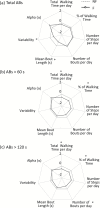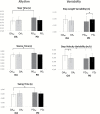Analysis of Free-Living Gait in Older Adults With and Without Parkinson's Disease and With and Without a History of Falls: Identifying Generic and Disease-Specific Characteristics
- PMID: 29300849
- PMCID: PMC6417445
- DOI: 10.1093/gerona/glx254
Analysis of Free-Living Gait in Older Adults With and Without Parkinson's Disease and With and Without a History of Falls: Identifying Generic and Disease-Specific Characteristics
Abstract
Background: Falls are associated with gait impairments in older adults (OA) and Parkinson's disease (PD). Current approaches for evaluating falls risk are based on self-report or one-time assessment and may be suboptimal. Wearable technology allows gait to be measured continuously in free-living conditions. The aim of this study was to explore generic and specific associations in free-living gait in fallers and nonfallers with and without PD.
Methods: Two hundred and seventy-seven fallers (155 PD, 122 OA) who fell twice or more in the previous 6 months and 65 nonfallers (15 PD, 50 OA) were tested. Free-living gait was characterized as the volume, pattern, and variability of ambulatory bouts (Macro), and 14 discrete gait characteristics (Micro). Macro and Micro variables were quantified from free-living data collected using an accelerometer positioned on the low back for one week.
Results: Macro variables showed that fallers walked with shorter and less variable ambulatory bouts than nonfallers, independent of pathology. Micro variables within ambulatory bouts showed fallers walked with slower, shorter and less variable steps than nonfallers. Significant interactions showed disease specific differences in variability with PD fallers demonstrating greater variability (step length) and OA fallers less variability (step velocity) than their nonfaller counterparts (p < 0.004).
Conclusions: Common and disease-specific changes in free-living Macro and Micro gait highlight generic and selective targets for intervention depending on type of faller (OA-PD). Our findings support free-living monitoring to enhance assessment. Future work is needed to confirm the optimal battery of measures, sensitivity to change and value for fall prediction.
Keywords: Falls; Gait; Parkinsons; Wearable Technology.
© The Author(s) 2017. Published by Oxford University Press on behalf of The Gerontological Society of America. All rights reserved. For permissions, please e-mail: journals.permissions@oup.com.
Figures



References
-
- Peel NM. Epidemiology of falls in older age. Can J Aging. 2011;30:7–19. doi:10.1017/S071498081000070X - PubMed
-
- Age UK. Falls in the Over 65s Cost NHS £4.6 Million a Day Press Release. 2010. http://www.ageuk.org.uk/latest-press/archive/falls-over-65s-cost-nhs/.
-
- Ross A, Yarnall AJ, Rochester L, Lord S. A novel approach to falls classification in Parkinson’s disease: Development of the fall-related activity classification (FRAC). Physiotherapy. 2016;103:459–464. doi:10.1016/j.physio.2016.08.002 - PubMed
Publication types
MeSH terms
Grants and funding
LinkOut - more resources
Full Text Sources
Other Literature Sources
Medical

